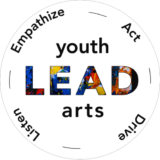(Today’s Blog is written by Roy Mulder, one of the youthLEADarts mentors.)
An opening comment was offered by Elder Amanda. She told of her beginnings and how she examined where she was hurt. It was the bridges that she built that allowed her to move forward. She said it was important to not let the student’s hurts take them down; look for people you can talk to shine past them.
Shelley summarized how the project will blend all the lessons and teachings together as we work on our productions. The students were in an optimistic frame of mind and were excited to continue with the program. The check-in was overwhelmingly positive in regards to their energy levels and their moods.
Tina conducted the warm-up and appointed a scribe for each group. Lori challenged the students to appoint tasks to those who aren’t necessarily the best at it. Using a word from each person they formed a sentence. It is a good exercise for using the L in LEAD which stands for Listen. Each group was required to put together sentences using the same methodology.
Lori stepped-up to provide the “meat in the sandwich”. She expressed what is required to create spoken word videos. She dialogued on how the art could be put in their productions using the video skills learned.
Lori requested the students to recite their poems for us. The students were coached to speak clearly and loudly during their readings. Their content was very relevant to our topic of racism and clearly demonstrated that they are doing well with the lessons. Some of the words were incredibly powerful in expressing their responses to racism. We are hearing the students use words like ‘resilience’ as part of their discussion on racism. Lori posed “Do you have a gateway line?” Each of the poems has this. She suggested using alliteration as part of their written words. They had all used simile and metaphor in their writing.
Roy conducted a dialogue on creating storyboards; what they are, how they work, why do we use them, and how important they are in creating video. The students were given handouts of a storyboard outline, and another with all the significant considerations a storyboard needs to address. The students were then given 15 minutes to create their storyboards in class. The teacher and assistant worked with the students to ensure that they were proceeding in the right direction. It’s clear that they have embraced the visual techniques and have a good grasp of the dialogue we are looking for.
The students are thinking about background sounds and other distractions. Since it is extremely difficult for everyone to work within the same classroom producing several videos at once, so the students are being given the opportunity to leave the classroom to harvest more scenes with more interesting visuals.
The last 7 minutes were spent talking about what is working for them and what isn’t. Emphasis is being put on details like having a strong establishing scene at the beginning and making sure that they harvest as many visual images as they can. Shelley did a wrap-up talking about different ways to enhance the interest level and applying it to the videos. She challenged them to provide visual metaphors to create even more impact for the words of their poems.


